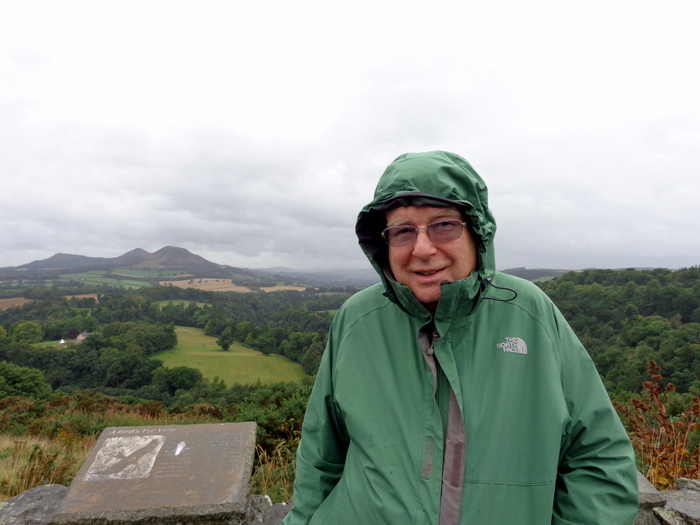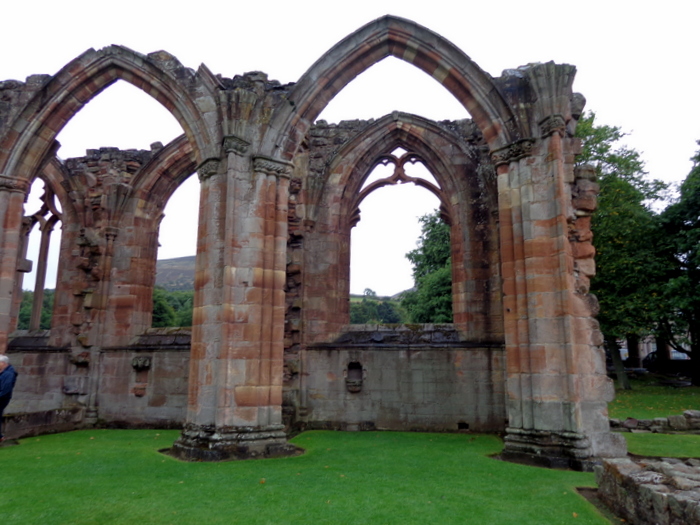CATHEDRAL QUEST
Our quest to experience the great cathedrals and churches of Europe
U.K. 2013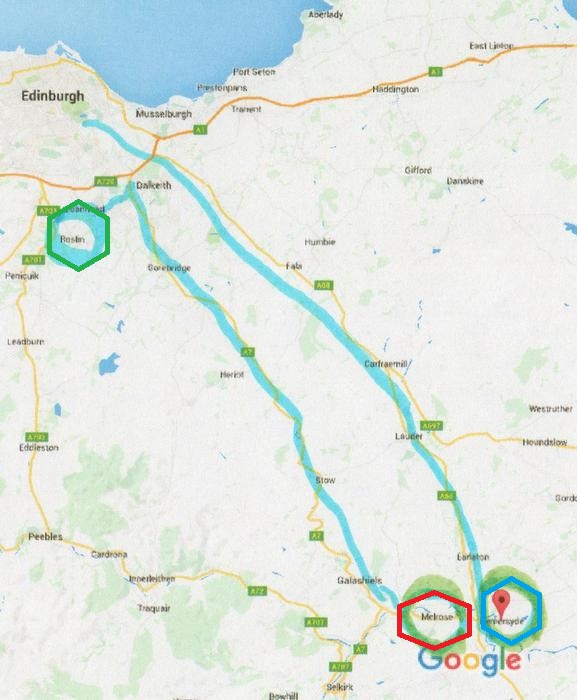
EDINBURGH
DAY 4, Friday, SEPT 6
Our plan for today was a van trip to Melrose Abbey and Rosslyn Chapel which began at 9:15, so we got up early. It was very over cast and looked like rain but we decided that we wanted to go any way. We had the usual wonderful breakfast buffet.
We took a taxi to the tour office. It was rather cold out plus it started raining. Our transportation was a beautiful Mercedes 16 passenger van. There were 14 people plus the tour guide. One fellow was from Ohio, two couples from Canada plus some English and Scots. We had an excellent tour guide who told us a lot Scottish history as well as much information about the places that we visited.
We drove for a little over an hour, passing through several small towns, until we came to a parking are along side the road at Bemersyde (blue circle on the map) not far from Melrose Abbey.
After about a 10 minute walk, which we had a hard time keeping up with the group, we came upon a 31 foot statue of William Wallace overlooking the River Tweed Valley. The statue depicting William Wallace as a Greek warrior was made of red sandstone by John Smith and was erected in 1814.
Sir William Wallace is considered one of Scotland’s greatest heroes. He
was opposed to the English rule under Edward I in the 13th century. Born
in 1272,the son of a minor Scottish lord, Wallace was educated and
rebellious. He was branded as an outlaw f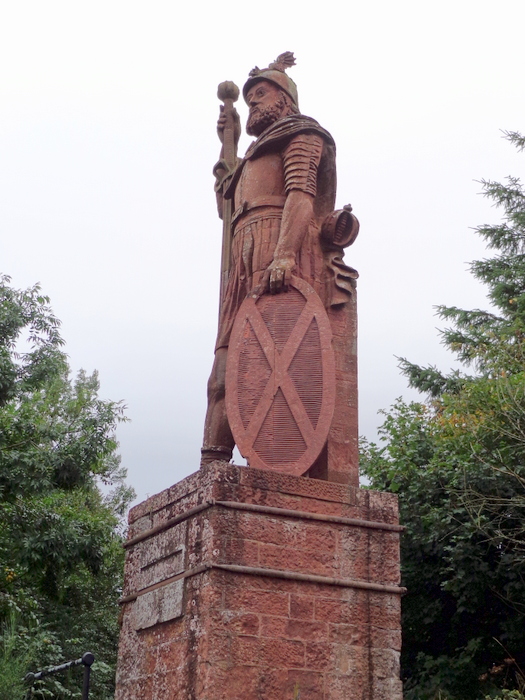 or killing an Englishman in
1292 and fled for the hills and formed an army to harass English
soldiers.
or killing an Englishman in
1292 and fled for the hills and formed an army to harass English
soldiers.
In 1297 Wallace and his army drove the English from Scotland and then invaded northern England. In December of 1297 Wallace was elected Guardian of the Kingdom and began to rule Scotland. Within the year Edward I defeated Wallace at Falkirk, and Wallace was forced to withdraw his forces.
He was captured in 1305 and taken to London, where he was convicted of treason and executed. Although much of his story is obscured by legend, it’s generally agreed that he was a very large, well-educated man who fought with passion and brilliant tactics. Some may remember him in Mel Gibson's 1995 movie Braveheart which is based on the life of Wallace.
Even though it was drizzling and rather cloudy and the Tweed River Valley was very beautiful. We hiked back to our van and soon came to the charming little town of Melrose (red circle on map).
MELROSE ABBEY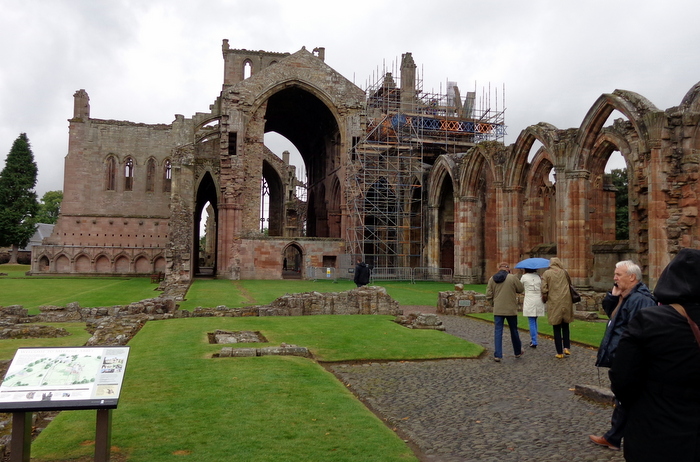
The main attraction here is the ruins of Melrose Abbey. We were given 1 ˝ hr. to explore the Abbey and eat lunch locally. We had audio guides for the Abbey.
Melrose Abbey was founded in the 12th century by the Cistercian order of monks. They were drawn to this fertile spot beside the River Tweed through its intimate associations with the holy men St. Aidan and St. Cuthbert. The Abby grew to become one of the wealthiest and most majestic medieval monasteries in Scotland. Among those who were buried there included Alexander II and Robert the Bruce.
The Abby suffered from the English during the war of indep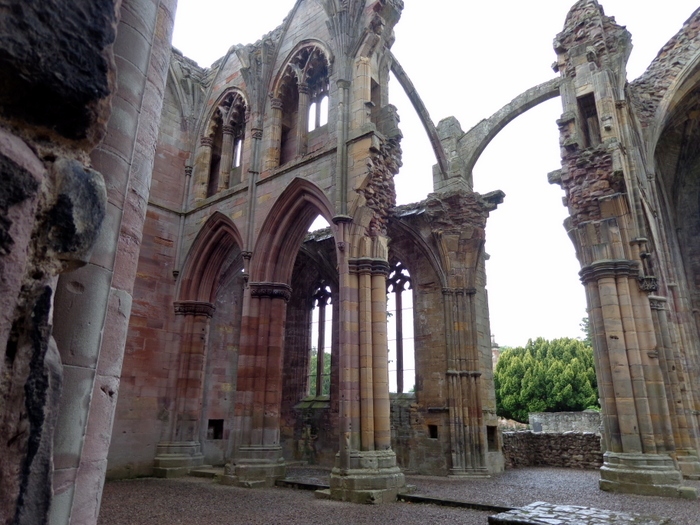 endence. The
present rose stone Abby church dates almost entirely from the rebuilding
following the devastating raid by Richard II Army in 1385, and is
regarded as one of the marvels of the church architecture be seen
anywhere in the British Isles.
endence. The
present rose stone Abby church dates almost entirely from the rebuilding
following the devastating raid by Richard II Army in 1385, and is
regarded as one of the marvels of the church architecture be seen
anywhere in the British Isles.
The new church resembled the earlier building but on a bigger scale. The transepts and presbytery were enlarged and extended further to the east series of chapels were built off the south side of the nave. The West End was never completed and the original front never entirely demolished.
In 1544, King Henry VIII had Melrose Abbey
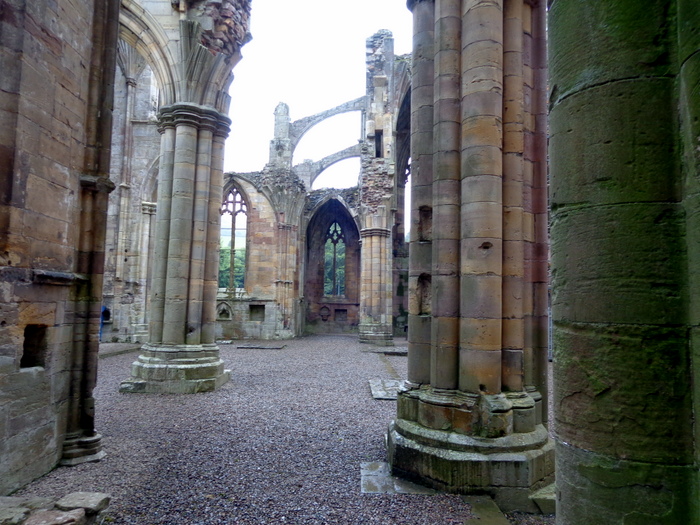 torched, and it never
recovered. Sixty of the monks, it is said, renounced Catholicism at the
Reformation. The last abbot was James Stuart, natural son of James V,
who died in 1559. By 1560, the abbey had ceased to function. The abbey's
holdings were given up in 1561.
torched, and it never
recovered. Sixty of the monks, it is said, renounced Catholicism at the
Reformation. The last abbot was James Stuart, natural son of James V,
who died in 1559. By 1560, the abbey had ceased to function. The abbey's
holdings were given up in 1561.
Its carvings were destroyed by a Protestant mob following the deposition of Mary, Queen of Scots. Finally, as has happened with many priceless works of antiquity, much of the abbey was carted off by locals needing building material.
The exterior of Melrose Abbey has 50 windows, 4 doors, 54 niches, and more than 50 buttresses. The abbey was damaged by the English in 1322 and 1384. Richard II made it a grant in 1389, as some compensation for the injuries it had sustained in the retreat of his army.
Part of it was being restored. It started to rain hard and since most o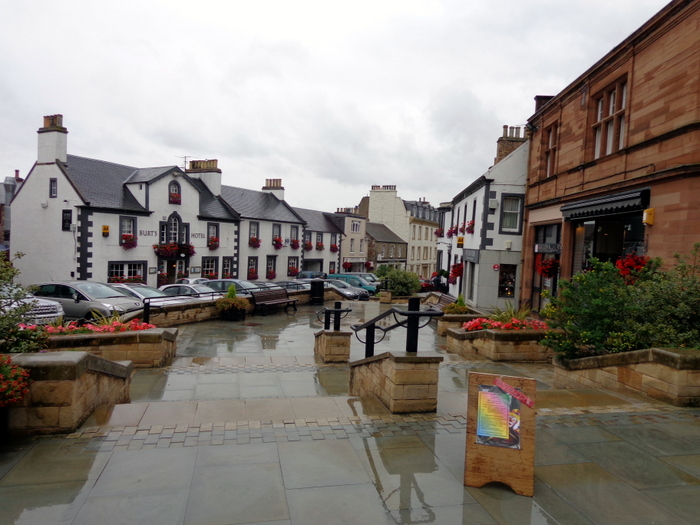 f
the Abbey didn’t have a roof, Kathleen and I decided to have lunch.
f
the Abbey didn’t have a roof, Kathleen and I decided to have lunch.
On the little main street was nice hotel with a quaint dining room. We had pea soup and pesto chicken open face sandwich with red onion marmalade. It was delicious. We got back to the van for the remainder of the trip.
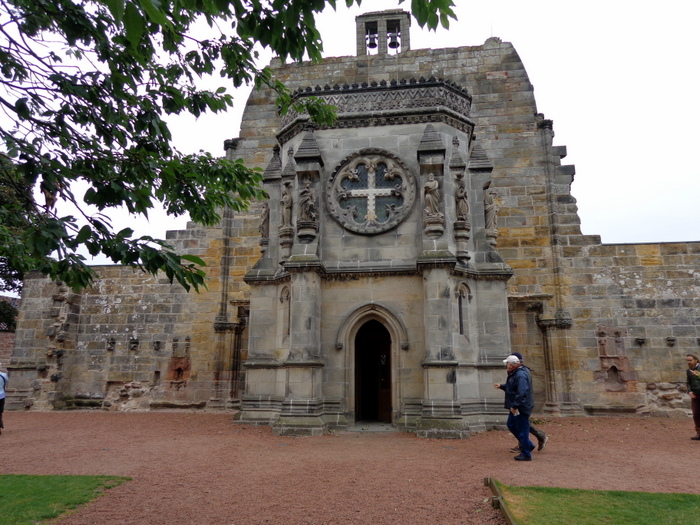 ROSSLYN
CHAPEL
ROSSLYN
CHAPEL
After about an hour, we arrived at Rosslyn Chapel (green circle on map). Rosslyn Chapel became famous because the final scenes of the Da Vinci Code were filmed there.
A lady who was in one of classes that I taught at Northern Va. Community College visited Rosslyn Chapel last year and found a paper model kit of the Chapel and sent it to me as a Christmas present last year. I made it several months ago. It was great fun seeing it in person. SEE MY MODEL
Rosslyn Chapel was founded in 1446 by Sir William St. Clair. It took 40 years to build only part of what was intended to be a larger cruciform building with the tower at its center. After Sir William died in 1484, he was buried in the unfinished Chapel and the larger building he had planned was never built.
On December 11, 1688, shortly after the Protestant William of
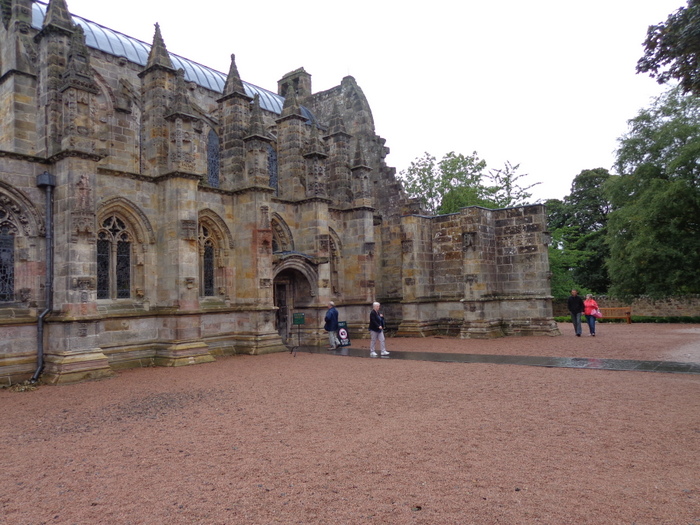 Orange
landed in England and displaced the Catholic James II, a mob from
Edinburgh and some villagers from Rosslyn entered and damaged the
Chapel. Their object was to destroy furniture, vestments, which now
were regarded as Popish and idolatrous.
Orange
landed in England and displaced the Catholic James II, a mob from
Edinburgh and some villagers from Rosslyn entered and damaged the
Chapel. Their object was to destroy furniture, vestments, which now
were regarded as Popish and idolatrous.
The Chapel remained abandoned until 1736, when Gen. James St. Clare
commission repairs which continued on and off for the next hundred
years. The Chapel was r ededicated in 1862.
ededicated in 1862.
In 1997 a free standing steel structure was erected to cover the Chapel to enable the stones of the roof vault to dry away from the interior surface. This structure was only removed a short time before our visit.
The inside is unbelievable with every stone surface carved with Bible Stories, saints, animals and plants. Photography inside was not permitted. At 3:00 one of the guides gave a talk. After an enjoyable visit, we headed back to Edinburgh, arriving about 4:15. It was raining hard and was cold, so we took a taxi back to our hotel.
We had reservations at Hadrian's restaurant at the Balmor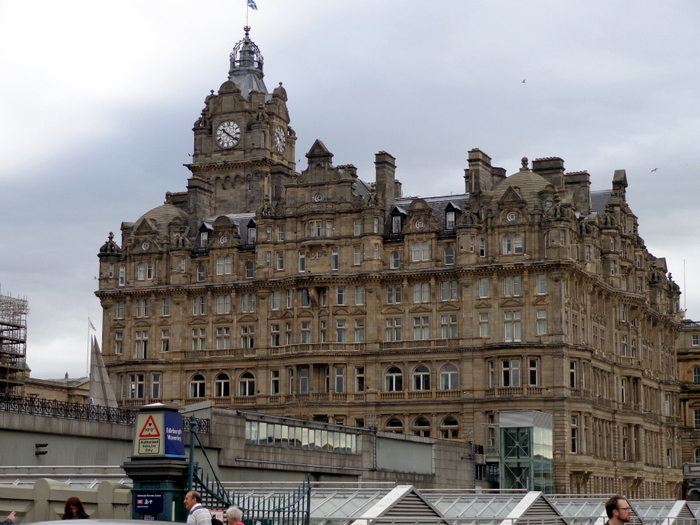 al Hotel,
near where we began our tour today, so we took another taxi ride. The
rain had gotten quite hard.
al Hotel,
near where we began our tour today, so we took another taxi ride. The
rain had gotten quite hard.
The restaurant was a nice place, with a modern décor. For a starter we shared a crab timbale with avocado. For the main course, Kathleen had Scottish Salmon and I had calves liver with onions and bacon plus we both had mashed potatoes. For dessert we shared a delicious tiramisu.
Guess what? Another taxi ride. It was pouring and the temp is about 55. We stopped in our bar and had Baileys Irish Cream. In spite of the rain, we was a very nice day. We have a lot of plans for tomorrow, but more rain is forecast.
NEXT DAY
PREFACE
Day 1 -Arrival in Edinburgh
Day
2 - Edinburgh
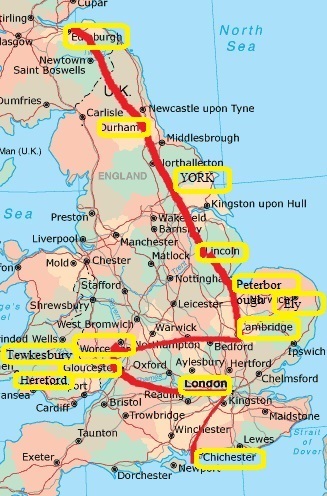
Day 3- Edinburgh to Inchcolm Abbey
Day 4 - Edinburgh to Melrose & Rosslyn
DAY 5 - Edinburgh
DAY 6 - Edinburgh
DAY 7 - York
DAY 8 - Durham
DAY 9 -York
DAY 10 - Lincoln
DAY 11 -Ely
DAY 12 - Peterborough
DAY 13 - Cambridge
DAY 14 - Ely to Worchester
DAY 15 - Tewkesbury and Gloucester
DAY 16 - Hereford
DAY l7 - London
DAY 18 - London
DAY 19 - London
DAY 20 - London to Guildford, Chichester, Midhurst
DAY 21 - London OUR LAST DAY
HOME

